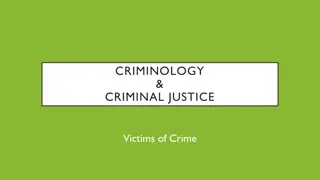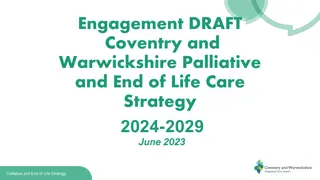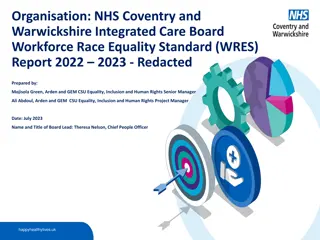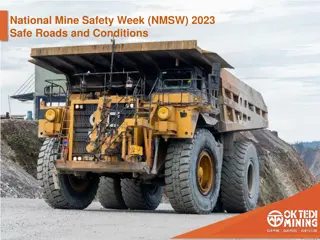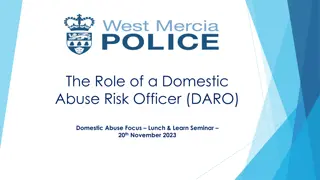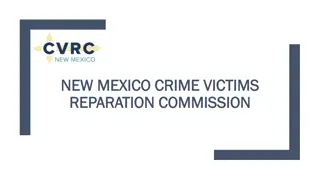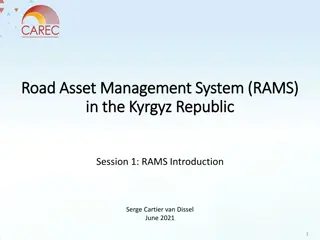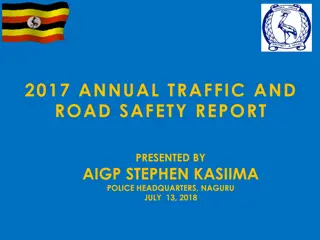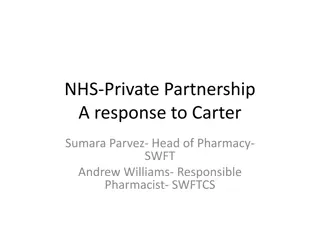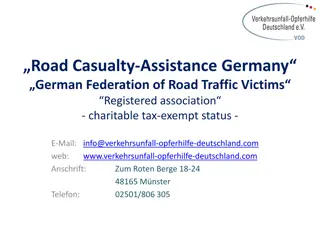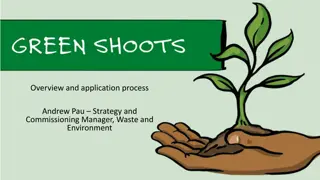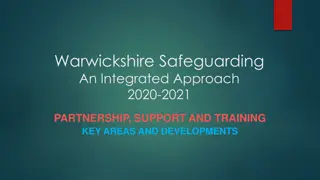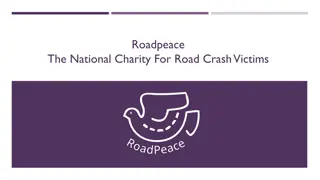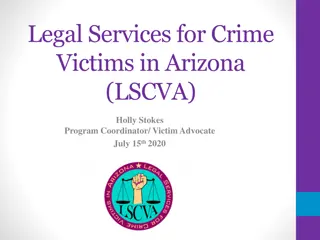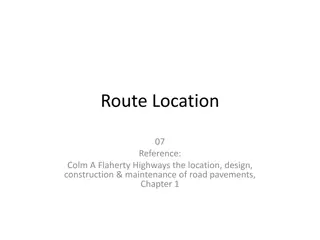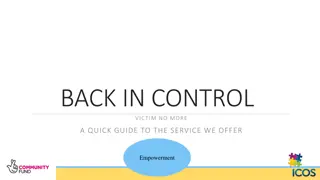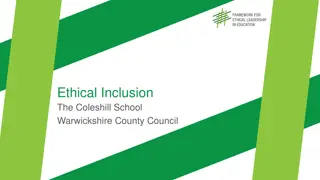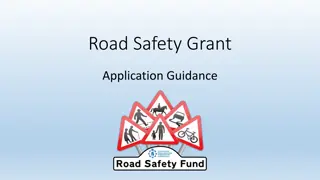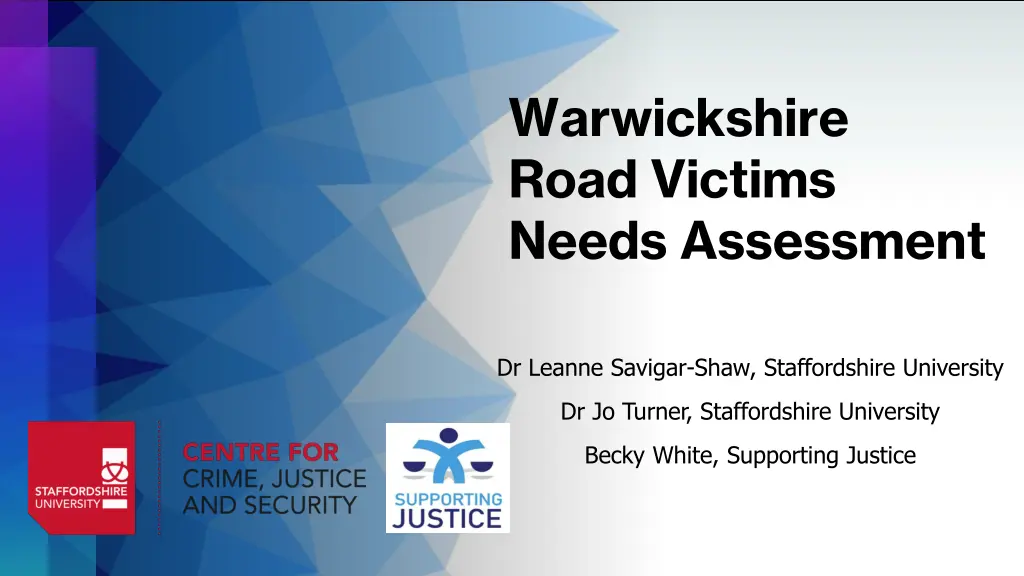
Understanding Road Victim Support: Data Analysis and Findings
Dive into the Warwickshire Road Victims Needs Assessment to uncover crucial insights on post-crash management, victim impact, and support provision. Discover findings on casualty data, FOI analysis, and support providers in the realm of road incidents.
Download Presentation

Please find below an Image/Link to download the presentation.
The content on the website is provided AS IS for your information and personal use only. It may not be sold, licensed, or shared on other websites without obtaining consent from the author. If you encounter any issues during the download, it is possible that the publisher has removed the file from their server.
You are allowed to download the files provided on this website for personal or commercial use, subject to the condition that they are used lawfully. All files are the property of their respective owners.
The content on the website is provided AS IS for your information and personal use only. It may not be sold, licensed, or shared on other websites without obtaining consent from the author.
E N D
Presentation Transcript
Warwickshire Road Victims Needs Assessment Dr Leanne Savigar-Shaw, Staffordshire University Dr Jo Turner, Staffordshire University Becky White, Supporting Justice
The roads context In the UK alone, over 1,500 people died in RTCs in 2021 more than double those killed in homicides and terrorism combined (DfT, 2021; House of Commons, 2021; ONS, 2022). Statistics from Warwickshire County Council recorded 16,634 collisions and 18,633 casualties between 2011 and 2020 (Warwickshire County Council, 2022). Post-crash management is key to physical and psychological return to normality (Peden et al, 2004; Balikuddembe et al, 2017).
Road Victims what do we already know? The impact of road incidents can be immense, affecting more than just those directly involved (Priya et al, 2021) and can vary in magnitude, type and timescale (Tehrani, 2004). Family support and access to information are key (Sabet et al., 2016). Fair police procedures, police engagement with victims, and use of appropriate language are important to those impacted by trauma (Elliot et al., 2012).
What did we do? Methodological approach 1. Analysis of Warwickshire Police road collision data from 2017-2021, 2. Police force FOI request analysis from 40 police forces, 3. Focus groups and interviews with 34 stakeholders, 4. Questionnaires with 8 stakeholders, 5. Interviews with 10 victims/survivors of RTCs, and 6. Questionnaires with 3 victims/survivors or RTCs.
Analysis casualty data 1507 people were killed or seriously injured on Warwickshire s roads between 2017 and 2021. Male car drivers aged 21-30 disproportionately account for all fatal casualties.
Analysis FOI data Eligibility criteria for victim support varies between force areas. Most forces provide support for both fatal and serious/life-changing collisions. Eligibility Most forces provide support to individuals directly injured and their next of kin. Some forces provide support to others.
Brake are the most commonly cited support provider, either via Brake packs, referrals or the IRVA service. Analysis FOI data Provision Most forces utilise FLOs as a form of support provision. Much victim provision is generic (not roads- specific). Victims supported What is considered road victim support varies between forces. Generic victim service uptake appears lower than that of other services.
Analysis Stakeholder data Harm in the roads context The road context is one of frequent and traumatic death/injury, making it difficult (but essential) to provide a high-quality victim service. A victim in a non-crime context Much road trauma is not crime-related. All have the potential to be impacted by, and therefore victims of, road trauma, including witnesses and perpetrators. The term victim may not be appropriate.
Analysis Stakeholder data Postcode lottery Support provision differs across geographies, funders and support providers. Self-referral mechanisms are possible, but awareness of services is a limitation. Areas for development FLOs may act as conduits to other support services but should not be service providers . Professionals may require support too. Greater awareness of services needed for public and professionals. Centralised support mechanisms could help alleviate the postcode lottery.
Analysis Affected people data Information and practical assistance Provision of information, expert advice and help to navigate processes most frequently stated and significant need. Diverse range of organisations and processes involved in the response to RTC. Advice for dealing with the press and social media. Service provision Lasting emotional impact of language and attitude of professionals (positive and negative). Proactive approaches required from service providers, with opt-out approach recommended to ensure those most in need receive support. Lack of choice in therapeutic services has potential to leave emotional support needs unmet.
Analysis Affected people data Legal contexts Civil: Awareness raising required to combat negative stereotypes of personal injury provision. Person-centred, reparative approach demonstrates victim support best practice. Opportunity for high quality services without OPCC funding. Criminal: Need for greater clarity around decisions to prosecute. Further work required to explore alternative justice solutions where criminal proceedings do not take place.
Discussion and recommendations - Context and terminology The roads context is unique and therefore support should be roads- specific We recommend commissioning a dedicated service to support road victims from the time of the incident through to the end of civil and criminal proceedings. No standard terminology for road victims currently exists, but the term victim can be problematic, potentially deterring support-seeking. We suggest that further research in this area focuses on the classification of road victims, to develop effective interventions and understand preferred terminology. We would provisionally recommend that support services be described as available to those impacted by road harm as an inclusive phrase.
Discussion and recommendations - Service provision Many people can be impacted by the trauma of RTCs, including direct and secondary victims , even where no crime occurs. We recommend that support is made available to all, including the culpable driver/their passengers, as well as witnesses. We recommend that where the CPS do not pursue a case, the victim is informed of the Victims Right to Review scheme. Informational and practical assistance is key (beyond emotional support) and choice provided victims with a sense of control and empowerment. The IRVA service was an important factor in cope and recovery. We recommend that a variety of support options are made available. We recommend that any future commissioned service includes an advocate role. We recommend that the services of the Air Ambulance are offered.
Discussion and recommendations - Referral and awareness The FLO can act as a meaningful conduit to services, but only where they are aware of services. Self-referral processes are not always clear. We recommend that victims are offered multiple opportunities to engage or re-engage with services following initial contact with the provider. We recommend training and awareness raising of the function of personal injury provision for FLOs and other relevant personnel. Personal injury solicitors had a positive impact on victim experiences. We recommend a robust triage stage within the initial and immediate response to road victims which should include referral to specialist personal injury solicitors for any appropriate cases.
Questions and comments How are the findings of this report relevant to your own practice? How can we overcome the existing barriers to create an effective and consistent response to road death and serious injury? How can we best generate impact in this area through our next steps?
Questions and comments Thank you for your attendance at this event. We welcome your feedback, questions and general comments.

